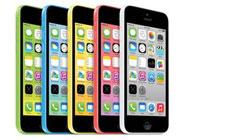As expected, Apple recently announced two new iPhones — the lower cost iPhone 5C and a follow-on to the iPhone 5 named the iPhone 5S. In a previous entry, I said that the new iPhone would not be named the iPhone 5S. I was wrong. The iPhone 5S does make sense in that the iPhone 3GS followed the iPhone 3G, and iPhone 4S followed the iPhone 4. But I didn’t think Apple would use the “S” suffix this time, since big changes to the device were expected. And Apple does have a history of incomprehensible model numbers. It seems the biggest news in the announcement is in how evolutionary — rather than revolutionary — these two new phones are. Compared to the iPhone 5, the iPhone 5S uses a new, faster processor and motion co-processor and includes a fingerprint reader on the home button. The iPhone 5C is a bigger and heavier than the 5S and uses an older, slower processor. The 5S feature a metal housing in three colors, while the 5C case is plastic in an assortment of colors. The iPhone 5S is the same size and weight as the iPhone 5, but offers longer battery life as well as the previously mentioned faster hardware. All three models seem to use the same screen, but Apple is advertising the brightness and contrast of the screen on the iPhone 5S and 5C. Apple has not specified the brightness and contrast of the screen of the iPhone 5-- the screen size and resolution was the main feature.
The iPhone's Reign
It’s easy to forget how revolutionary the original iPhone was. The idea of a touchscreen was not new, but using fingers and gestures rather than a stylus was. The look and operation of the phone was clean and simple, appealing to a large number of people previously intimidated by smartphones. Overnight the iPhone's innovation made Apple a leader in the mobile phone market, putting the previous leaders, RIM, Palm (remember Palm?), and Nokia, at a huge disadvantage. Palm never recovered, while RIM is merging with Nokia. Today, Apple and Samsung/Google own the smartphone market, with a combined market share of 64 percent. If you add all other manufactures of Android smartphones, the combined iOS/Android market share is 94 percent. iOS and Android phones actually work in similar ways and have similar features. Effectively, Apple and Samsung/Google have defined what a smartphone is today. Indeed, there have been numerous lawsuits between them to determine who created which features and who is violating which patents.
Time for a Re-Assertion of Power?
Given this history, everyone had high hopes for a breakthrough product in the iPhone 5S, but it seems the world is not ready for another breakthrough. The original iPhone came at a time when technology allowed for a revolutionary device and the world was ready for a revolution. The iPhone 5S and 5C add incremental features to a solid platform, with the main feature of the 5C being its lower cost. Though, I’m guessing the “C” in the model name is for color, not cost.
